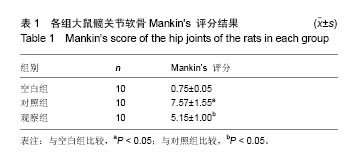| [1]Sen ES, Clarke SL, Ramanan AV. The child with joint pain in primary care. Best Pract Res Clin Rheumatol. 2014;28(6): 888-906.[2]Chambers HG. Update on neuromuscular disorders in pediatric orthopaedics: Duchenne muscular dystrophy, myelomeningocele, and cerebral palsy. J Pediatr Orthop. 2014;34 Suppl 1:S44-48.[3]Mazloumi SM, Ebrahimzadeh MH, Kachooei AR. Evolution in diagnosis and treatment of Legg-Calve-Perthes disease. Arch Bone Jt Surg. 2014;2(2):86-92. [4]Chaudhry S, Phillips D, Feldman D. Legg-Calvé-Perthes disease: an overview with recent literature. Bull Hosp Jt Dis (2013). 2014;72(1):18-27.[5]Johnson ZI, Shapiro IM, Risbud MV. Extracellular osmolarity regulates matrix homeostasis in the intervertebral disc and articular cartilage: evolving role of TonEBP. Matrix Biol. 2014; 40:10-16. [6]Demoor M, Ollitrault D, Gomez-Leduc T, et al. Cartilage tissue engineering: molecular control of chondrocyte differentiation for proper cartilage matrix reconstruction. Biochim Biophys Acta. 2014;1840(8):2414-2440.[7]O'Conor CJ, Case N, Guilak F. Mechanical regulation of chondrogenesis. Stem Cell Res Ther. 2013;4(4):61. [8]王永明,王峰,邵婷,等. MSCs复合双相磷酸钙陶瓷促进腰椎骨折患者脊柱融合[J]. 现代生物医学进展, 2015,15(33): 6484-6486.[9]傅淑平,张荣华.不同浓度梓醇对SD大鼠骨髓间充质干细胞增殖及骨向分化的影响[J]. 时珍国医国药, 2012,23(10): 2398-2400.[10]Liu XX, Li XH, Zhou JT. Experimental study on replicating knee osteoarthritis by modified Hulth's modeling method. Zhongguo Zhong Xi Yi Jie He Za Zhi. 2005;25(12): 1104-1108.[11]Gerlier D, Thomasset N. Use of MTT colorimetric assay to measure cell activation. J Immunol Methods. 1986;94(1-2): 57-63.[12]McCloskey TW, Oyaizu N, Coronesi M, et al. Use of a flow cytometric assay to quantitate apoptosis in human lymphocytes. Clin Immunol Immunopathol. 1994;71(1): 14-18.[13]van der Sluijs JA, Geesink RG, van der Linden AJ, et al. The reliability of the Mankin score for osteoarthritis. J Orthop Res. 1992;10(1):58-61.[14]Bahmanyar S, Montgomery SM, Weiss RJ, et al. Maternal smoking during pregnancy, other prenatal and perinatal factors, and the risk of Legg-Calvé-Perthes disease. Pediatrics. 2008;122(2):e459-464.[15]Mohammadi H, Mequanint K, Herzog W. Computational aspects in mechanical modeling of the articular cartilage tissue. Proc Inst Mech Eng H. 2013;227(4):402-420.[16]Mabvuure N, Hindocha S, Khan WS. The role of bioreactors in cartilage tissue engineering. Curr Stem Cell Res Ther. 2012;7(4):287-292.[17]Galle J, Bader A, Hepp P, et al. Mesenchymal stem cells in cartilage repair: state of the art and methods to monitor cell growth, differentiation and cartilage regeneration. Curr Med Chem. 2010;17(21):2274-2291.[18]Bao JP, Chen WP, Wu LD. Lubricin: a novel potential biotherapeutic approaches for the treatment of osteoarthritis. Mol Biol Rep. 2011;38(5):2879-2885.[19]Lee HS, Huang GT, Chiang H, et al. Multipotential mesenchymal stem cells from femoral bone marrow near the site of osteonecrosis. Stem Cells. 2003;21(2):190-199.[20]Wieczorek G, Steinhoff C, Schulz R, et al. Gene expression profile of mouse bone marrow stromal cells determined by cDNA microarray analysis. Cell Tissue Res. 2003;311(2): 227-237.[21]Abukawa H, Terai H, Hannouche D, et al. Formation of a mandibular condyle in vitro by tissue engineering. J Bone Joint Surg Am. 2005;87(5):936-944.[22]Jaiswal N, Haynesworth SE, Caplan AI, et al. Osteogenic differentiation of purified, culture-expanded human mesenchymal stem cells in vitro. J Cell Biochem. 1997; 64(2):295-312.[23]刘玉艳. N,O-羧甲基壳聚糖/纳米β-磷酸三钙复合材料的制备及其生物学性能的基础研究[D]. 长春:吉林大学, 2011.[24]Webster TJ, Ergun C, Doremus RH, et al. Specific proteins mediate enhanced osteoblast adhesion on nanophase ceramics. J Biomed Mater Res. 2000;51(3):475-483.[25]Schumacher M, Uhl F, Detsch R, et al. Static and dynamic cultivation of bone marrow stromal cells on biphasic calcium phosphate scaffolds derived from an indirect rapid prototyping technique.J Mater Sci Mater Med. 2010;21(11):3039-3048.[26]Park JC, Oh SY, Lee JS, et al. In vivo bone formation by human alveolar-bone-derived mesenchymal stem cells obtained during implant osteotomy using biphasic calcium phosphate ceramics or Bio-Oss as carriers. J Biomed Mater Res B Appl Biomater. 2016;104(3):515-524.[27]Lobo SE, Glickman R, da Silva WN, et al. Response of stem cells from different origins to biphasic calcium phosphate bioceramics. Cell Tissue Res. 2015;361(2):477-495.[28]Li B, Liao X, Zheng L, et al. Effect of nanostructure on osteoinduction of porous biphasic calcium phosphate ceramics. Acta Biomater. 2012;8(10):3794-3804.[29]Mitri F, Alves G, Fernandes G, et al. Cytocompatibility of porous biphasic calcium phosphate granules with human mesenchymal cells by a multiparametric assay. Artif Organs. 2012;36(6):535-542.[30]王涛,田卫东,刘磊,等.新型多孔纳米双相磷酸钙陶瓷支架体外细胞相容性的实验研究[J].华西口腔医学杂志,2005,23(2): 106-109.[31]Hu J, Yang Z, Zhou Y, et al. Porous biphasic calcium phosphate ceramics coated with nano-hydroxyapatite and seeded with mesenchymal stem cells for reconstruction of radius segmental defects in rabbits. J Mater Sci Mater Med. 2015;26(11):257.[32]Kim DH, Shin KK, Jung JS, et al. The Role of Magnesium Ion Substituted Biphasic Calcium Phosphate Spherical Micro-Scaffolds in Osteogenic Differentiation of Human Adipose Tissue-Derived Mesenchymal Stem Cells. J Nanosci Nanotechnol. 2015;15(8):5520-5523.[33]张晓强.骨髓间充质干细胞复合β-TCP生物陶瓷修复山羊骨软骨缺损的实验研究[D].广州:南方医科大学, 2009.[34]Talakoob S, Joghataei MT, Parivar K, et al. Capability of Cartilage Extract to In Vitro Differentiation of Rat Mesenchymal Stem Cells (MSCs) to Chondrocyte Lineage. Int J Mol Cell Med. 2015;4(1):9-21.[35]陆勇,陈克敏,丁晓毅. 关节软骨磁共振生理性成像临床应用[J]. 国际骨科学杂志,2006,27(4):200-202. [36]郝鹏,裴福兴. 关节软骨损伤后体外培养软骨细胞的功能变化[J]. 中国组织工程研究, 2011, 15(28):5131-5135. |
.jpg)




.jpg)